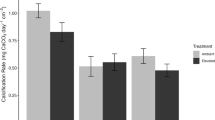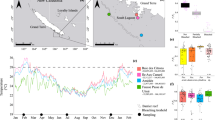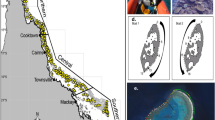Abstract
The coral reef ecosystems in the Lakshadweep Sea are among the least studied due to the dearth of in situ measurements. The objectives of this study were to compare the remote sensing datasets with the available in situ measurements and confirm the reliability of the former for further studies in this region. The study also examines how the sea surface temperature and salinity triggered coral bleaching during El Niño southern oscillation (ENSO)/Indian Ocean dipole (IOD) events. We found that satellite observations of sea surface temperature (r = 0.94) and salinity (r = 0.81) correlated well with in situ measurements. Such a high degree of correlation enabled us to analyse satellite data for inter-annual variations like ENSO and IOD. In the study area, coral bleaching due to salinity variation was found to be negligible. The study delineates a coral bleaching threshold temperature and the prevalence of such warm waters in the coral environment. Analysis revealed a mass coral bleaching peak during the El Niño event in 2016, with a maximum prevalence of 78 days. Similarly, significant coral bleaching events were observed in 2010 (El Niño; 63 days) and 2019 (PIOD; 56 days). Maximum temperature was noticed during the spring inter-monsoon (March to May). But from 2015, intense warming in the coral region was also noticed in the fall inter-monsoon (October). Combined with global warming, the threat of thermal stress to corals may continue in the long term, which will negatively impact the health of reef ecosystems.







Similar content being viewed by others
Data availability
The satellite data used in this study can be accessed freely from their respective websites, and the field survey data can be obtained by contacting the corresponding author, Muraleedharan K. R., upon reasonable request.
References
Abram NJ, Gagan MK, Cole JE et al (2008) Recent intensification of tropical climate variability in the Indian Ocean. Nat Geosci 1:849–853
Ahmad SM, Padmakumari VM, Raza W et al (2011) High-resolution carbon and oxygen isotope records from a scleractinian (Porites) coral of Lakshadweep archipelago. Quat Int 238:107–114
Arthur R (2000) Coral bleaching and mortality in three Indian reef regions during an El Niño southern oscillation event. Curr Sci 79(12):1723–1729
Baker AC, Glynn PW, Riegl B (2008) Climate change and coral reef bleaching: an ecological assessment of long-term impacts, recovery trends and future outlook. Estuar Coast Shelf Sci 80:435–471
Bamston AG, Chelliah M, Goldenberg SB (1997) Documentation of a highly ENSO-related SST region in the equatorial Pacific: research note. Atmos Ocean 35:367–383
Bellwood DR, Pratchett MS, Morrison TH et al (2019) Coral reef conservation in the Anthropocene: confronting spatial mismatches and prioritizing functions. Biol Conserv 236:604–615
Castillo KD, Lima FP (2010) Comparison of in situ and satellite-derived (MODIS-Aqua/Terra) methods for assessing temperatures on coral reefs. Limnol Oceanogr Methods 8:107–117
Claar DC, Szostek L, McDevitt-Irwin JM et al (2018) Global patterns and impacts of El Niño events on coral reefs: a meta-analysis. PLoS ONE 13:e0190957
Donner SD, Skirving WJ, Little CM et al (2005) Global assessment of coral bleaching and required rates of adaptation under climate change. Glob Chang Biol 11:2251–2265
Eladawy A, Nadaoka K, Negm A et al (2015) Assessment of long term thermal stress on egyptian coral reefs based on remotely sensed sea surface temperature data. Int J Environ Sci Dev 6:938
Fisher R, O’Leary RA, Low-Choy S et al (2015) Species richness on coral reefs and the pursuit of convergent global estimates. Curr Biol 25:500–505
Glynn PW (1991) Coral reef bleaching in the 1980s and possible connections with global warming. Trends Ecol Evol 6:175–179
Glynn PW, D’croz L (1990) Experimental evidence for high temperature stress as the cause of El Niño-coincident coral mortality. Coral Reefs 8:181–191
Guan Y, Hohn S, Merico A (2015) Suitable environmental ranges for potential coral reef habitats in the tropical ocean. PLoS ONE 10:e0128831
Head CEI, Bayley DTI, Rowlands G et al (2019) Coral bleaching impacts from back-to-back 2015–2016 thermal anomalies in the remote central Indian Ocean. Coral Reefs 38:605–618
Hedley JD, Roelfsema CM, Chollett I et al (2016) Remote sensing of coral reefs for monitoring and management: a review. Remote Sens 8:118
Hoegh-Guldberg O (1999) Climate change, coral bleaching and the future of the world’s coral reefs. Mar Freshw Res 50:839–866
Hoegh-Guldberg O, Mumby PJ, Hooten AJ et al (2007) Coral reefs under rapid climate change and ocean acidification. Science (80-) 318:1737–1742
Hoegh-Guldberg O, Cai R, Poloczanska ES, Brewer PG, Sundby S, Hilmi K, Fabry VJ, Jung S (2014) The Ocean. In: Barros VR, Field CB, Dokken DJ, Mastrandrea MD, Mach KJ, Bilir TE, Chatterjee M, Ebi KL, Estrada YO, Genova RC, Girma B, Kissel ES, Levy AN, MacCracken S, Mastrandrea PR, White LL (eds) Climate Change 2014: Impacts, Adaptation, and Vulnerability. Part B: Regional Aspects. Contribution of Working Group II to the Fifth Assessment Report of the Intergovernmental Panel on Climate Change. Cambridge University Press, Cambridge, United Kingdom and New York, NY, USA, pp 1655–1731
Hoon V (1997) Coral reefs of India: review of their extent, condition, research and management status. In: Proceedings of the Regional Workshop on the conservation and sustainable management of coral reefs. MS. Swaminathan Research and BOBP, Chennai. pp 1–25
Hughes TP, Baird AH, Bellwood DR et al (2003) Climate change, human impacts, and the resilience of coral reefs. Science (80-) 301:929–933
Idrees Babu KK, Kumar SS (2016) Status and changing trends of coral reefs in Lakshadweep archipelago after 1998 mass bleaching event–long term monitoring survey. Int J Appl Pure Sci Agric 163–175
Jayakrishnan PR, Babu CA, Varikoden H (2014) Coral reef bleaching in the Indian Ocean associated with the Indian Ocean Dipole. Clim Chang Mar Ecosyst 90
Kleypas JA, McManus JW, Meñez LAB (1999) Environmental limits to coral reef development: where do we draw the line? Am Zool 39:146–159
Kleypas JA, Castruccio FS, Curchitser EN, Mcleod E (2015) The impact of ENSO on coral heat stress in the western equatorial Pacific. Glob Chang Biol 21:2525–2539
Kumagai NH, Yamano H (2018) High-resolution modeling of thermal thresholds and environmental influences on coral bleaching for local and regional reef management. PeerJ 6:e4382
Kumar SP, Prasad TG (1999) Formation and spreading of Arabian Sea high-salinity water mass. J Geophys Res Ocean 104:1455–1464
Kumaresan S, Shekhar S, Chakraborty S et al (2018) Environmental variables and nutrients in selected islands of Lakshadweep Sea; Addressing coral bleaching. Reg Stud Mar Sci 22:38–48
Lathlean JA, Ayre DJ, Minchinton TE (2011) Rocky intertidal temperature variability along the southeast coast of Australia: comparing data from in situ loggers, satellite-derived SST and terrestrial weather stations. Mar Ecol Prog Ser 439:83–95
Li A, Reidenbach MA (2014) Forecasting decadal changes in sea surface temperatures and coral bleaching within a Caribbean coral reef. Coral Reefs 33:847–861. https://doi.org/10.1007/s00338-014-1162-1
Lough JM (1994) Climate variation and El Nino-southern oscillation events on the Great Barrier Reef: 1958 to 1987. Coral Reefs 13:181–185
Madhupratap M, Kumar SP, Bhattathiri PMA et al (1996) Mechanism of the biological response to winter cooling in the northeastern Arabian Sea. Nature 384:549–552
Mallik TK (2017) Coral atolls of Lakshadweep, Arabian Sea, Indian Ocean. MOJ Eco Env Sci 2:68–83
McClanahan TR, Ateweberhan M, Graham NAJ et al (2007) Western Indian Ocean coral communities: bleaching responses and susceptibility to extinction. Mar Ecol Prog Ser 337:1–13
McCreary JP Jr, Kundu PK, Molinari RL (1993) A numerical investigation of dynamics, thermodynamics and mixed-layer processes in the Indian Ocean. Prog Oceanogr 31:181–244
Meyers G, McIntosh P, Pigot L, Pook M (2007) The years of El Niño, La Niña, and interactions with the tropical Indian Ocean. J Clim 20:2872–2880
Morrison TH, Adger N, Barnett J et al (2020) Advancing coral reef governance into the Anthropocene. One Earth 2:64–74
Nobi EP, Dinesh Kumar PK (2014) Environmental characteristics of tropical coral reef-seagrass dominated lagoons (Lakshadweep, India) and implications to resilience to climate change. Environ Earth Sci 72:1025–1037
Plaisance L, Caley MJ, Brainard RE, Knowlton N (2011) The diversity of coral reefs: what are we missing? PLoS ONE 6:e25026
Podestá GP, Glynn PW (2001) The 1997–98 El Nino event in Panama and Galapagos: an update of thermal stress indices relative to coral bleaching. Bull Mar Sci 69:43–59
Prakash TN, Nair LS, Hameed TSS (2014) Geomorphology and physical oceanography of the Lakshadweep coral islands in the Indian Ocean. Springer
Preacher KJ, Selig JP (2012) Advantages of Monte Carlo confidence intervals for indirect effects. Commun Methods Meas 6:77–98
Rao GN, Kumar KA, Jagadeesh PS V, Anand P (2014) Characteristics of bay of Bengal water mass in south eastern Arabian Sea during 2001–2002
Rasmusson EM, Carpenter TH (1982) Variations in tropical sea surface temperature and surface wind fields associated with the southern oscillation/El Niño. Mon Weather Rev 110:354–384
Ratna SB, Cherchi A, Osborn TJ et al (2021) The extreme positive Indian Ocean dipole of 2019 and associated Indian summer monsoon rainfall response. Geophys Res Lett 48:e2020GL091497
Risbey JS, Pook MJ, McIntosh PC et al (2009) Characteristics and variability of synoptic features associated with cool season rainfall in southeastern Australia. Int J Climatol A J R Meteorol Soc 29:1595–1613
Rowlands G, Purkis S, Riegl B et al (2012) Satellite imaging coral reef resilience at regional scale. A case-study from Saudi Arabia. Mar Pollut Bull 64:1222–1237
Saji NH, Yamagata T (2003) Possible impacts of Indian Ocean dipole mode events on global climate. Clim Res 25:151–169
Saji NH, Goswami BN, Vinayachandran PN, Yamagata T (1999) A dipole mode in the tropical Indian Ocean. Nature 401:360–363. https://doi.org/10.1038/43854
Santoso A, England MH, Cai W (2012) Impact of Indo-Pacific feedback interactions on ENSO dynamics diagnosed using ensemble climate simulations. J Clim 25:7743–7763
Sebens KP (1994) Biodiversity of coral reefs: what are we losing and why? Am Zool 34:115–133
Shankar D, Shetye SR (1997) On the dynamics of the Lakshadweep high and low in the southeastern Arabian Sea. J Geophys Res Ocean 102:12551–12562
Shankar D, Vinayachandran PN, Unnikrishnan AS (2002) The monsoon currents in the north Indian Ocean. Prog Oceanogr 52:63–120
Shenoi SSC, Shankar D, Shetye SR (1999) On the sea surface temperature high in the Lakshadweep Sea before the onset of the southwest monsoon. J Geophys Res Ocean 104:15703–15712
Sheppard CRC (2003) Predicted recurrences of mass coral mortality in the Indian Ocean. Nature 425:294–297
Shi W, Wang M (2021) A biological Indian Ocean Dipole event in 2019. Sci Rep 11:1–8
Smitha BR, Sanjeevan VN, Vimalkumar KG, Revichandran C (2008) On the upwelling off the southern tip and along the west coast of India. J Coast Res 24(4C):95–102
Sreekesh S (2016) Rainfall variation in Lakshadweep Islands. Ind J Geo Mar Sci 45(11):1603–1609
Stobart B, Mayfield S, Mundy C et al (2015) Comparison of in situ and satellite sea surface-temperature data from South Australia and Tasmania: how reliable are satellite data as a proxy for coastal temperatures in temperate southern Australia? Mar Freshw Res 67:612–625
Stocker T (2014) Climate change 2013: the physical science basis: Working Group I contribution to the Fifth assessment report of the Intergovernmental Panel on Climate Change. Cambridge University Press, Cambridge, United Kingdom and New York, NY, USA. https://doi.org/10.1017/CBO9781107415324
Thakur KK, Vanderstichel R, Barrell J et al (2018) Comparison of remotely-sensed sea surface temperature and salinity products with in situ measurements from British Columbia. Canada Front Mar Sci 5:121
Trenberth KE (1997) The definition of el nino. Bull Am Meteorol Soc 78:2771–2778
Vargas-Ángel B, Zapata FA, Hernández H, Jiménez JM (2001) Coral and coral reef responses to the 1997–98 El Niño event on the Pacific coast of Colombia. Bull Mar Sci 69:111–132
Vijaykumar K, Mehra P, Nair B et al (2014) Mean surface meteorological parameter characterization at Kavaratti, Lakshadweep Island, South-East Arabian Sea, West Coast of India. NISCAIR-CSIR, India
Vivekanandan E, Hussain Ali M, Jasper B, Rajagopalan M (2008) Thermal thresholds for coral bleaching in the Indian seas. J Mar Biol Assoc India 50:209–214
Vivekanandan E, Rajagopalan M, Pillai NGK (2009) Recent trends in sea surface temperature and its impact on oil sardine. In: Global Climate Change and Indian Agriculture. Indian Council of Agricultural Research, New Delhi, pp 89–92
Winter A, Appeldoorn RS, Bruckner A et al (1998) Sea surface temperatures and coral reef bleaching off La Parguera, Puerto Rico (northeastern Caribbean Sea). Coral Reefs 17:377–382
Wu Y, Sheng J, Senciall D, Tang C (2016) A comparative study of satellite-based operational analyses and ship-based in-situ observations of sea surface temperatures over the eastern Canadian shelf. Satell Oceanogr Meteorol 1:29–38
Yi X, Hünicke B, Tim N, Zorita E (2018) The relationship between Arabian Sea upwelling and Indian monsoon revisited in a high resolution ocean simulation. Clim Dyn 50:201–213
Acknowledgements
The authors of the study are grateful to the Director and Scientist in Charge of the National Institute of Oceanography in Goa and Kochi for providing facilities throughout the paperwork. Also, we thank the Department of Science and Technology (DST) in Lakshadweep and REEF NGO in Lakshadweep for their support in conducting the field survey and express acknowledgement for the participation of the boat’s crew. We wish to record a special thanks to the staff who are working on the project MLP 2013. This is CSIR-NIO contribution no:
Funding
The project MLP 2013 was funded by the Council of Scientific & Industrial Research (CSIR), India, and CSIR-National Institute of Oceanography, India.
Author information
Authors and Affiliations
Contributions
Ravikumar C. Nair managed the field survey, data analysis, and writing of the manuscript. Muraleedharan K. R. identified the problem, field survey, analysis, and interpretation of the data. Ravikumar C. Nair and Abdul Azeez S. were involved in downloading data and preparing the figures. Dinesh Kumar P. K. administered the project and contributed to the discussion. All authors reviewed and approved the final manuscript.
Corresponding author
Ethics declarations
Ethical approval
This article does not contain any studies with human participants or animals performed by any of the authors.
Consent to participate
For this type of study, formal consent is not required.
Conflict of interest
The authors declare no competing interests.
Additional information
Responsible Editor: Andrea Pinones
Supplementary Information
Below is the link to the electronic supplementary material.
Rights and permissions
Springer Nature or its licensor (e.g. a society or other partner) holds exclusive rights to this article under a publishing agreement with the author(s) or other rightsholder(s); author self-archiving of the accepted manuscript version of this article is solely governed by the terms of such publishing agreement and applicable law.
About this article
Cite this article
Nair, R.C., KR, M., S, A. et al. Relationship between coral bleaching and large-scale oscillations in the Lakshadweep archipelago. Ocean Dynamics 73, 463–474 (2023). https://doi.org/10.1007/s10236-023-01562-y
Received:
Accepted:
Published:
Issue Date:
DOI: https://doi.org/10.1007/s10236-023-01562-y




